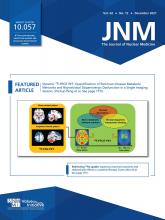I first became excited about prostate-specific membrane antigen (PSMA) as a game-changing target for nuclear medicine at the 2011 European Association of Nuclear Medicine meeting in Birmingham. The target had been identified 2 decades beforehand (1,2). A new approach using radiolabeled small-molecule ligands that target the extracellular domain of the PSMA receptor, however, showed striking tumor-to-background contrast in both preclinical models with 99mTc or 124I/131I and in a 68Ga first-in-humans image of a patient with prostate cancer. I recorded PSMA as my “Image of the Conference.” The images provided the clarity needed in order to be rapidly adopted by groups into clinical practice and trials in both imaging and therapy. A decade has passed, and we now have 2 Food and Drug Administration–approved PSMA ligands, 68Ga-PSMA-11 and 18F-DCFPyL. And we also have VISION, a phase 3 trial of radioligand therapy, that has led to Food and Drug Administration breakthrough approval of 177Lu-PSMA-617.
The VISION trial, presented at the American Society of Clinical Oncology 2021 meeting and recently published in The New England Journal of Medicine (3), included men with metastatic castration-resistant prostate cancer who had previous treatment with at least 1 taxane chemotherapy and 1 androgen receptor pathway inhibitor. Thirteen percent were excluded after 68Ga-PSMA-11 PET/CT selection; 551 men were randomized to 177Lu-PSMA-617 and 280 to the standard of care. Although the standard of care can be criticized for being protocol-defined and potentially limiting optimal clinical care options, the trial was designed with a goal of Food and Drug Administration approval and the results will enable widespread, global availability for men with prostate cancer. This availability is expected to follow, given the improvement in overall survival of 15.3 mo with 177Lu-PSMA-617, compared with 11.3 mo with the standard of care. This improvement was consistent across prespecified stratification factors, including lactate dehydrogenase, liver metastases, and androgen-receptor pathway inhibitors planned as part of the standard of care. Other endpoints, such as response on CT (RECIST response, 42% vs. 3%) and a prostate-specific antigen decline of over 50% (46% vs. 7%), also impressively favor 177Lu-PSMA-617.
Like many other types of radionuclide therapy that are now widely available, 177Lu-PSMA-617 has followed a development pathway that is unusual compared with conventional pharmaceuticals. The very first treatments were compassionate-access treatments at Bad Berka (4) and the University of Heidelberg (5) in Germany in men who had progressed after standard therapies. The unique ability to see what you treat with theranostics enabled the confidence to administer a treatment never tested before in a human. Years of experience with 68Ga/177Lu-DOTATATE in neuroendocrine tumors enabled estimation of an appropriate administered radioactivity. Posttreatment dosimetry instantly validated high tumor targeting with low normal-organ uptake (6). Such a direct mechanistic treatment paradigm has features more analogous to external-beam radiotherapy, enabling rapid translation to the clinic.
At the Peter MacCallum Cancer Centre, we designed a prospective phase II study in 2014. Our vision was that a small prospective trial would provide the type of evidence required to evaluate activity and safety and to move this treatment into the mainstream. The results of this 30-patient trial were published in Lancet Oncology (7,8) and are currently the topic of the top 10 most highly cited articles in the journal since 2008. Without a commercial sponsor but with support from the ANZUP Clinical Trials Group and grant funding, these results led directly to the first randomized controlled trial of 177Lu-PSMA-617, the TheraP trial. ABX, manufacturer and owner of the PSMA-617 intellectual property at the time, and ANSTO, which manufactures 177Lu in Australia, kindly agreed to the support trial. Our expanded 50-patient cohort (7) provided Endocyte with compelling phase 2 evidence contributing to its purchase of PSMA-617 and design of the phase 3 VISION trial (9). Around a year later, Novartis purchased Endocyte and spearheaded global commercialization.
We now have 2 randomized trials of 177Lu-PSMA-617 providing complementary evidence. VISION provides definitive survival data on men who have exhausted current therapeutic options. The TheraP trial places PSMA theranostics 1 step earlier by comparing with cabazitaxel (10), showing greater efficacy, lower toxicity, and better patient-reported outcomes. VISION demonstrates efficacy in a broader population, whereas TheraP used quantitative PET and also 18F-FDG PET/CT for patient selection. It remains an open question whether men with relatively low-intensity PSMA uptake or 18F-FDG–positive PSMA-negative disease benefit from this treatment.
We recently celebrated the anniversary of the first administration of radioiodine by Saul Hertz on March 31, 1941. Eighty years later, the nuclear medicine community continues to innovate with truly personalized medicine. As a last line of treatment, outcomes with 177Lu-PSMA remain modest for many men, although some experience truly exceptional and durable responses. I am hopeful that multiple efforts are also under way to evaluate novel combinations and that use of 177Lu-PSMA earlier, even as a first line of treatment (11,12), will further improve outcomes for men with prostate cancer.
DISCLOSURE
Michael Hofman is supported by the Prostate Cancer Foundation (PCF), funding the Prostate Cancer Theranostics and Imaging Centre of Excellence (ProTIC), with additional grant funding from Movember, Victorian Cancer Agency (VCA), and the U.S. Department of Defense. Michael Hofman has also received speaker fees, travel support, or fees for advisory board participation from Astella, AstraZeneca, Janssen, Merck/MSD, Mundipharma, and Point Biopharma, as well as research support from Endocyte and Advanced Accelerator Applications (Novartis companies). Michael Hofman was also the principal investigator of the TheraP study, funded by the Prostate Cancer Foundation of Australia (PCFA), with community support from Movember, It’s a Bloke Thing Foundation, and Can4Cancer. ANSTO supplied no-carrier-added 177Lu. No other potential conflict of interest relevant to this article was reported.
Footnotes
Published online August 12, 2021.
- © 2021 by the Society of Nuclear Medicine and Molecular Imaging.
REFERENCES
- Received for publication July 11, 2021.
- Revision received July 16, 2021.







